The reprint issues of the “Honolulu Star-Bulletin” Pearl Harbor issue…
May 14, 2012 by TimHughes · 30 Comments
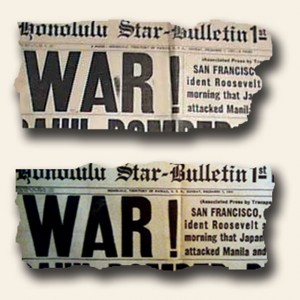 If there is a second in line for the most common phone call or email about a newspaper which turns out to be a reprint, it would be the December 7, 1941 of the “Honolulu Star-Bulletin – 1st Extra“.
If there is a second in line for the most common phone call or email about a newspaper which turns out to be a reprint, it would be the December 7, 1941 of the “Honolulu Star-Bulletin – 1st Extra“.
The genuine issue is arguably the best newspaper to have reporting the historic bombing of Pearl Harbor, being a dramatic headline, from the day it happened, and from where it happened. And consequently those conditions make it ripe for creating a reprint edition. From what I understand the reprints are still available at the souvenir shop at the Pearl Harbor memorial.
There are a couple of tell-tale indicators which are easily observed:
* The genuine issue has an ink smear between the “A” and “R” in the huge “WAR ! ” in the headline.
* The reprint edition does not have the ink smear, it having been “cleaned up” to make for a better appearance.
* The genuine “1st Extra” is 8 pages and does not have the “2nd Extra” nor the “3rd Extra” within, as they were separate, stand-alone edition printed later in the day. The reprint editions typically have one of both of the later editions on pages 3 and/or 5.
* At least one of the reprint edition has the front page of the “Honolulu Advertiser” newspaper on page 3. Obviously a competing newspaper’s front page would not be found within a genuine issue of the “Star-Bulletin”.
As if the above are not sufficient in determine a genuine from reprint edition, the photos of the reprints typically have a “muddy” appearance and are not as crisp & clear as would be found in the genuine issue.
Genuine or reprint?
March 26, 2009 by TimHughes · 30 Comments
A great fear of any novice collector is knowing whether an item purchased is genuine or not. It’s a valid concern, as the other collectibles have been infested by reproduction,s reprints, or deceivingly fake material from furniture to coins to baseball collectibles.
The world of rare newspapers is not immune but it is not a serious problem either. With a few helpful hints almost every collector can avoid the pitfalls of having non-genuine newspapers end up in their collection.
Fake material of any collectible seems to become an problem when popularity and values grow. Since rare newspaper collecting remains a relatively unknown hobby with relatively low prices there is little incentive to create fake editions. And the requirements to recreate a 200 year old newspaper to have it look like a genuine edition can be complex and expensive.
With but one exception, I am not aware of any reprinted newspapers which were created to deceive. Virtually all facsimile issues on the market were created as souvenirs of historic events (Honolulu issues on Pearl Harbor can still be purchased at the memorial), on anniversaries of the first issue printed (many volume one, number one issues are reprints), as curious give-aways or “premiums” (major events such as the Boston Massacre, Declaration of Independence, etc. were reprinted), or as teaching tools in an educational environment (Harper’s Weekly issues from the Civil War were reprinted on their 100th anniversary: look for “a reissue of” above the “H” in “Harper’s Weekly” on page 1).
The lone exception is a collection of the “Pennsylvania Gazette” from the 1730’s – 1787 with issues turning up in small auction halls throughout the East some 20 years ago. The issues were aged to look 200 years old and the paper was very close to genuine newsprint from the era. Beware of this title if it contains a “Tontine Coffee House” inked stamp on the front page & if it looks a bit washed out.
The number of reprint newspapers on the market is exceedingly small so collectors have little to worry about. But keep these points in mind:
1) The most common reprint newspapers are on the Library of Congress check-list. Go here to keep the list handy. It also includes helpful tips on how to tell if genuine or a reprint.
2) Be aware of what 200 year old and 100 year old newsprint should look like. Almost all reprints were done on paper which is not reflective of the era.
3) Be suspicious of exceedingly historic newspaper turning up in illogical places. The likelihood of a genuine Declaration of Independence report being in flea market or amongst of group of papers from a non-collecting family is very remote. In other words if the find seems too good to be true, it likely is.
4) Be careful with volume one, number one newspapers. Such first editions were commonly reprinted by the publisher on the 50th or 100th anniversary.
5) Above all, buy from reputable dealers whose expertise, experience and reputation stand behind all they sell.
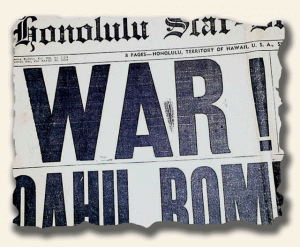 The “Honolulu Star-Bulletin” of Dec. 7, 1941 mentioned above is not on the Library of Congress check-list, however it’s easy to spot a reprint. The genuine issue has an ink smear between the “A” and “R” in the huge word “WAR!” on the front page (see photo). They cleaned it up on the reprint so it won’t be present.
The “Honolulu Star-Bulletin” of Dec. 7, 1941 mentioned above is not on the Library of Congress check-list, however it’s easy to spot a reprint. The genuine issue has an ink smear between the “A” and “R” in the huge word “WAR!” on the front page (see photo). They cleaned it up on the reprint so it won’t be present.
And a news flash–I just learned that the “Dallas Morning News” issue of Nov. 23, 1963 reporting Kennedy’s assassination has been reprinted. Look for the word “Reprint” in the dateline just after the four stars. Do note those we have on our website & have sold for over 20 years are all genuine!
Common sense can be the best guide. The requirements to reprint an 8 page Civil War newspaper with a minor battle report could cost hundreds of dollars while the genuine issue might sell for $20, so chances are good such finds are genuine. For this reason our hobby is a fascinating one not prone to the pitfalls of other collectibles.
Our community of collectors is quite small which has worked in our favor. All of us are in an enviable position of being able to assemble great collections of historic material before the world at large “discovers” our hobby and changes the environment in years to come.
Enjoy!
Most Popular History’s Newsstand Posts – January 2023 update
February 3, 2023 by GuyHeilenman · Leave a Comment
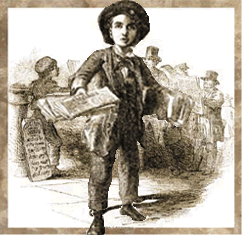 Whereas some posts are time-sensitive, others have staying power. Although the History Newsstand Blog (sponsored by RareNewspapers.com) has been operating for nearly 15 years and has thousands of entries, certain posts have consistently appeared in the “Top Ten Most Popular Posts” list shown on the right-side menu. The top half-dozen as of this post are:
Whereas some posts are time-sensitive, others have staying power. Although the History Newsstand Blog (sponsored by RareNewspapers.com) has been operating for nearly 15 years and has thousands of entries, certain posts have consistently appeared in the “Top Ten Most Popular Posts” list shown on the right-side menu. The top half-dozen as of this post are:
- Do Old and Antique Newspapers Have Any Collectible Value?
- Setting values for collectible newspapers…
- Genuine or reprint?
- Framing and Storing Newspapers… the ongoing story…
- More on printing newspapers in the 1700’s…
- More on printing newspapers in the 1700’s…
- The reprint issues of the “Honolulu Star-Bulletin” Pearl Harbor issue…
In regard to the most popular (Do Old and Antique Newspapers Have Any Collectible Value?), if you ever have an old newspaper and are curious as to its potential (approximate) value, please contact us directly (info@rarenewspapers.com) as we do not respond through the post itself.
WW2 Era Newspapers Found In The Attic… Are They Worth Anything?
October 25, 2021 by GuyHeilenman · Leave a Comment
Perhaps the most common inquiry we receive concerns newspapers from World War II found in parents’ attics. As generations pass it is incumbent upon their children to sort out what is of value and what is not.
The list which follows is a guide for determining what to keep and what to dispose.
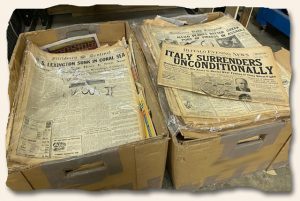 In general, there are only about 15 events which are sufficiently notable to excite most collectors. Those event not included on the list are considered “generic” or “atmosphere” issues which, although reporting much on the war, are generally not significant enough to draw the attention of the serious collector.
In general, there are only about 15 events which are sufficiently notable to excite most collectors. Those event not included on the list are considered “generic” or “atmosphere” issues which, although reporting much on the war, are generally not significant enough to draw the attention of the serious collector.
It’s worth noting that graphic appeal tends to trump title. Example: the New York Times remains one of the more notable newspapers of the 20th century, but their headlines were typically conservative, lacking any drama, flash, or graphic appeal. Small town newspapers with dramatic graphic appeal will be more desired.
Issues which fit the events and criteria noted below could well have collector value. Feel free to send the exact title and date of each along with photos of the entire front pages (showing margins) to: info@rarenewspapers.com
Note: Perhaps the mostly commonly reprinted issue of the war is the Honolulu Star-Bulletin of Dec. 7, 1941. Most of the issues on the market are the common reprint, still sold at the souvenir stand at the U.S.S. Arizona Memorial in Honolulu. See this blog post on how to tell a reprint from the genuine issue.
Top 15 events of World War II:
1) Germany invades Poland, 9/1/1939
* This event marked what many regard as the start of the war. Although not an American
event, most collectors want this report among their holdings.
2) Attack on Pearl Harbor, 12/7/1941
* Japan’s naval air force attacks military bases on Oahu, Hawaii, thus thrusting the United States into the war. The more dramatic and shocking the wording in a banner headline the better.
3) U.S. Declares war against Japan, 12/8/1941
* Just one day after the attack on Pearl Harbor the United States officially declares war against Japan, formalizing America’s entry in the war in the Pacific.
4) U.S. declares war against Germany & Italy, 12/11/1941
* The United States enters the war in Europe as well, just 3 days after declaring war against Japan.
5) Battle of Midway, 6/4-7/1942
* Just six months after Pearl Harbor the United States scores a major naval victory in the Pacific against Japan. Being a multi-day event, collectors would pursue the best headline near the end of the battle reporting the American victory.
6) D-Day, 6/6/1944
* With Axis forces controlling much of Western Europe, this day marks the offensive of the Allied forces in re-taking conquered countries. The word “Invasion” is desired somewhere within the headlines.
7) Battle of the Bulge, 12/16/1944
* This was the last major German offensive on the Western Front taking place from December 16, 1944 to January 25, 1945. Issues near the end of the battle which reported an Allied victory would be more desired.
8) Photo of the flag raising on Mt. Suribachi, Iwo Jima, 2/23/1945
* If there was a single, iconic photo of American successes in the Pacific it would be this Pulitzer Prize-winning photo. Many newspapers included it in their editions of a day or two later, many did not. Better if the photo is on the front page, as many newspapers—when using it—did so on an inside page.
9) Death of FDR, 4/12/1945
* Although arguably not a true war event, the death of the President who was Commander-In- Chief of the military through almost the entirety of the war cannot be missed as a notable event.
10) Death of Hitler, 4/30/1945
* Hitler’s suicide deep inside a Berlin bunker essentially ended the war in Europe as just days later terms of surrender were agreed to by Nazi officials. Most newspapers reported his death on May 2, and a few published the Nazi propaganda report that the Fuehrer: “…has fallen in battle at the head of the heroic defenders of the Reich capital…”. The blunt words: “Hitler Dead” are more dramatic than “Death of Hitler”.
11) V-E Day, 5/7/1945
* The official end of the War in Europe. This was one event where newspapers often used patriotic embellishments to celebrate the victory, some multi-colored, some incorporating war photos within letters, etc.
12) Atomic bomb drop on Hiroshima, 8/6/1945
* With the war in the Pacific still raging, the first atomic bomb ever deployed was dropped over the city of Hiroshima. Some newspaper down-played the horrific affects of the bomb. More desired are headlines which more accurately reported the incredible devastation.
13) Atomic bomb drop on Nagasaki, 8/9/1945
* Just 3 days after Hiroshima, the second atomic bomb was dropped, which prompted the Japanese to pursue surrender terms. Again, bluntly accurate reporting in the headline is desired over a more subdued report.
14) V-J Day, 8/15/1945
* Terms for surrender were agreed upon, and the world announced the end of World War II. Much like V-E Day, newspapers typically became very creative in patriotically celebrating the end of the war. The more creative the front page the better.
15) Formal surrender of Japan, ending WWII, 9/2/1945
* Signing of the surrender terms happened on board the U.S.S. Missouri in Tokyo Bay. Although most collectors would consider V-J Day as the end of the war, and in many respects it was, collectors often pursue this event as well.
There are also 2nd-tier items which could be collectible, but the extent of coverage and graphic appeal are paramount, and in some cases the title/publisher is essential. The list below contains such items, and will be updated from time-to-time.
Pre-War
Nuremberg Laws enacted, 9/15/1935
Jews no longer permitted to own property (various)
Opening of Concentration Camps (various)
Kristallnacht, 11/9-10/1938
During The War
Fake Report of attack on Los Angeles, “Battle of Los Angeles” (2/25/1942)
Bismarck Sunk, 5/27/2941
Star of David Badge, 9/7/1941
Doolittle Raid , 4/18-20/1942
USS Lexington Lost, 6/12/1942
Bataan Death March, 1/28/1944
JFK PT Boat, 6/11/1944
MacArthur returns to the Philippines, 10/20/1944
Post-War
USS Missouri – Peace Treaty Signed, 9/2/1945
Louis Zamperini Found, 9/9/1945
Patton’s Death, 12/21/1945
The top ten: “20th century”…
December 28, 2009 by TimHughes · 9 Comments
From this period in newspaper publishing history, displayability has much to do with the desirability of a newspaper, perhaps more so than historical significance. Since I come to this task of listing the “top ten” from the perspective of a rare newspaper dealer and knowing the requests we receive for certain events, the following list may not be the same as my most “historic” but they are my thoughts for the most “desirable” based on customer demand. Certainly FDR’s New Deal is more historically significant than the death of Bonnie & Clyde, but not more desirable from a collector standpoint. I’d be curious to hear of your thoughts.
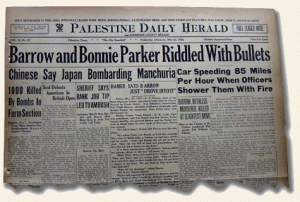 Here they are, beginning with number ten:
Here they are, beginning with number ten:
10) St. Valentine’s Day Massacre, Feb. 14, 1929 An issue with a dramatic banner headline, & ideally dated the 14th. Morning papers would be dated the 15th.
9) Death of Bonnie & Clyde, May 23, 1934 The gangster era remains much in demand, & perhaps due to the movie this event beats out Dillinger, Capone & the others from the era. A dramatic headline drives desirability–ideally with a photo–even if not in a Louisiana newspaper.
8.) Charles Lindbergh flies the Atlantic, May 22, 1927 The New York Times had a nice headline account with a map of the route, and the prestige of the newspaper always keeps it in high demand.
 7) Call-Chronicle-Examiner, San Francisco, April 19, 1906 I note a specific title & date for this event, as these 3 newspapers combined to produce one 4 page newspaper filled with banner heads & the latest news. No advertisements.
7) Call-Chronicle-Examiner, San Francisco, April 19, 1906 I note a specific title & date for this event, as these 3 newspapers combined to produce one 4 page newspaper filled with banner heads & the latest news. No advertisements.
6) Crash of the Hindenberg, May 6, 1937 The more dramatic the headline the better, & ideally with the Pulitizer Prize winning photo of the airship in flames.
5) Wright brothers fly, Dec. 17, 1903 Here’s where the significance of the event drives desirability over dramatic appeal. Few can argue the impact of manned flight on the world. Reports were typically brief & buried on an inside page with a small headline, so a lengthy front page report would be in top demand.
4) Stock market crash, October, 1929 Demand is driven by the dramatic headline and its wording. Too many newspapers tried to put an optimistic spin on the tragedy. Collectors want “collapse, disaster, crash” & similarly tragic words in the headline (how about Variety magazine’s: “Wall Street Lays On Egg”?)
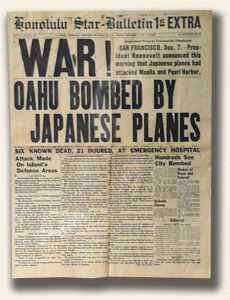 3) Honolulu Star-Bulletin, Dec. 7, 1941 “1st Extra” The defining issue from World War II but be careful of reprints as most issues on the market are not genuine.
3) Honolulu Star-Bulletin, Dec. 7, 1941 “1st Extra” The defining issue from World War II but be careful of reprints as most issues on the market are not genuine.
2) Chicago Daily Tribune, Nov. 3, 1948 “Dewey Defeats Truman”. What more need be said?
1) Titanic sinking, April 14, 1912 Certainly low on the historically significant list, but off the charts on the desirability scale, much due to the block-busting movie. The more dramatic the headline the better, and hopefully with a nice illustration of the ship going down.
My “honorable mention” list might include baseball’s “Black Sox” scandal of 1919, sinking of the Lusitania, end of World War II, D-Day, JFK’s election, the New Deal, a great Babe Ruth issue, etc. Maybe they would rank higher on your list.


